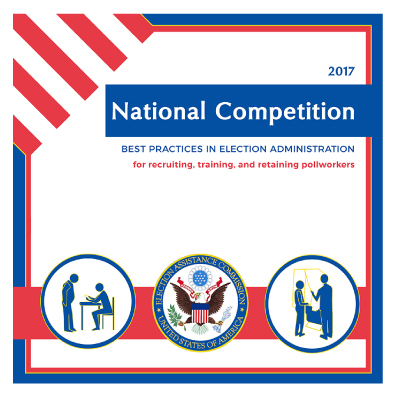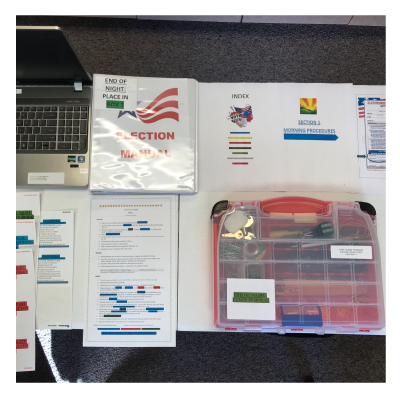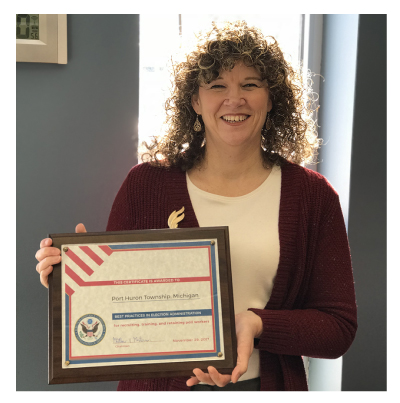 In November of 2017, the EAC announced the winners of our annual national competition for best practices in election administration, also known as the “Clearies.” Leading up to the 2018 elections, we will be periodically highlighting both Clearie winners and entries that didn’t receive an award, but still provide good models for election officials. It is our hope these best practices will help election officials enhance their processes and prepare for future elections.
In November of 2017, the EAC announced the winners of our annual national competition for best practices in election administration, also known as the “Clearies.” Leading up to the 2018 elections, we will be periodically highlighting both Clearie winners and entries that didn’t receive an award, but still provide good models for election officials. It is our hope these best practices will help election officials enhance their processes and prepare for future elections.
Port Huron Township, Michigan received an award in our Recruitment, Training, and Retention of Poll Workers category. This week, we caught up with Benita Davis, Port Huron’s Clerk, whose office designed a simplified and effective election worker training which provides each worker with a custom, color-coded and easy to understand manual.
Please tell us about Port Huron’s award-winning poll worker training and operations processes.
 Benita Davis: Instead of over-providing instructions, resources, and manuals, we offer the bare minimum while maintaining all legal compliance and catering to the needs of our workers. The more broken down, simplified, and straightforward the process can be, the higher the accuracy.
Benita Davis: Instead of over-providing instructions, resources, and manuals, we offer the bare minimum while maintaining all legal compliance and catering to the needs of our workers. The more broken down, simplified, and straightforward the process can be, the higher the accuracy.
We color code or cross-reference all materials. If you have a supply box that needs to have specific items in it, how does your worker know what items they should place in that box? For us, we decided to utilize colored labels. For example, we have a green box that has supplies in it (like laptops, boxes with pens and pencils, etc.) that are all color-coded green. This helps with a quick visual check of what goes where. This process is very simple, and costs almost nothing.
At the end of the night, each precinct reports to a receiving board which serves as the final check to verify the accuracy of the precinct. They review that everything is sealed, confirm final results, etc. For this, we have a giant “admission ticket,” which is a day-long checklist that the precinct chair or other designated inspector complete throughout the day. Again, every supply or essential item is highlighted in the color of the bag/box it will end up in. This helps keep people on track throughout the day.
Our certification training is 90 percent hands on. We give a brief overview of the process, system, and key legal points then break into smaller groups and perform Election Day related tasks utilizing our manuals and resources. This teaches our workers to reference their resources and become comfortable with them, and it engages adult learning and memory.
Polling places and the poll workers who run them are on the front line of American elections. What resulted from these changes and how did it impact Port Huron Township’s poll workers?
Benita Davis: Our changes were 100 percent focused on the poll worker. The simpler and more straightforward we could make this process for them, the more they could enjoy the process and perform with great accuracy. We noticed a dramatic increase in accuracy, worker attitude, and confidence after these changes were made.
In the recent 2016 federal election, approximately 917,694 poll workers served voters across the U.S. What sparked your interest in creating these innovative programs to assist poll workers in Port Huron?
 Benita Davis: Although there are a lot of poll workers, they sometimes work as little as one election (or none) per year. This makes the process for them difficult to remember. It was our goal to make sure that we had everything laid out to support this dedicated group of workers. The easier we made their life, the better retention we would have with our workers. They do a hard job, and we just want to make it easier for them.
Benita Davis: Although there are a lot of poll workers, they sometimes work as little as one election (or none) per year. This makes the process for them difficult to remember. It was our goal to make sure that we had everything laid out to support this dedicated group of workers. The easier we made their life, the better retention we would have with our workers. They do a hard job, and we just want to make it easier for them.
During the 2016 elections, nearly 117,000 polling places served voters across America. Given your innovative initiatives, what tips or best practices do you recommend to election officials seeking to develop similar poll worker training and operations processes?
Benita Davis: Every jurisdiction is different. Some things that work for us won’t work for others. However, I think if clerks are confident in election law and can establish a foundation of what their legal responsibilities are, they can begin to streamline each process to meet that fundamental goal - then build from there. Then, track the types of calls your office receives on Election Day because that can be a telling sign of the types of things that you must reinforce with training.
We would like to extend a big thank you to Benita Davis and her office for sharing details on their innovative poll worker training efforts. As election officials across the U.S. work to improve poll worker training, the Port Huron initiative helps to serve as a model effort. Please check in later this month, as we continue highlighting participants in our Clearies competition.

